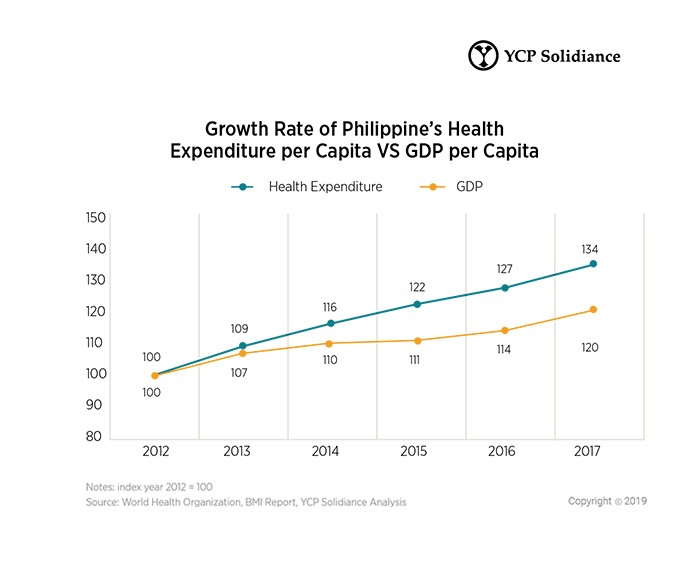

Since 2012, healthcare costs in the Philippines have surpassed per capita GDP growth and hit an increase of 20% in just a span of two years. Total health expenditure grew from PHP 593 billion in 2015 to PHP 712 billion in 2017.
Digitization in healthcare can address gaps including rising health care costs, lack of human resources and infrastructure in the Philippines, according to YCP Solidiance’s latest report titled “Can Digitization Fix the Philippines’ Healthcare Challenges?”.
In the Philippines, the healthcare industry faces various issues such as rising costs, changing medical needs, and lack of infrastructure. This had led to a lower quality of services being offered to patients. More so, some patients do not receive any healthcare service at all.

As health conditions evolve, the need for more advanced and specialized treatments emerge. Policymakers, healthcare providers, and pharmaceutical firms are compelled to scale up their research and development efforts to meet these changing needs.
With the rising demand for healthcare, the Philippine eHealth Bill was created to complement the UHC Act with the goal of digitizing healthcare delivery systems. Opportunities for digitization start to emerge in the healthcare industry such as establishing health information systems, utilizing electronic patient records, and offering online services to patients and automating certain operational processes.
Through digitization a few benefits have emerged such as reducing cost through increased efficiency, addressing of constraints and increase access, as well as enabling more complex research and development.
With digitization, efficiency improved by cutting down the time and resources needed to complete specific processes and tasks. Utilizing fewer resources and workforce effectively reduces the cost for healthcare providers while maintaining the quality of service. Moreover, digitization had created an alternative means for healthcare providers to reach their patients. Providers are able to utilize portals and applications with their patients. The applications are also used to better equip their staff with additional knowledge and skills. In addition, the digitalization of healthcare data increases the accuracy and efficiency of analysis, leading to more advanced services, such as epidemiology surveillance.
However, even with the benefits that have raised from digitization in the healthcare section, there are still many challenges. Healthcare digitization requires the participation and cooperation of all key stakeholders working within the value chain and. Unfortunately, this is not yet the case for the Philippines due to a number of external and internal factors.
Download the full report to gain more insights on "Can Digitization Fix The Philippines' Healthcare Challenges?".

Leading the Charge: Major Players in SEA’s Digital Lending Market
The fintech lending market in SEA is poised for substantial growth, including digital lending which is set to surpass digital payments as the primary revenue driver for the region's digital financial services sector by 2025, with a compound annual growth rate (CAGR) of 33%. This growth is fueled by the widespread adoption of automated loan origination processes and the seamless integration of financial services into digital platforms.

Unlocking Opportunities in the SEA Digital Financial Services Landscape
In recent years, Southeast Asia (SEA) has emerged as a hotbed for fintech innovation, transforming the financial landscape across its diverse markets. This transformation is characterized by a surge in digital financial services (DFS), revolutionizing how individuals and businesses manage their finances. However, the journey is not without its challenges, and understanding these is crucial for stakeholders aiming to navigate this rapidly evolving sector.

How SEA Startups are Navigating Funding Challenges
The startup ecosystem in Southeast Asia (SEA) has long been a vibrant hub for innovation and growth. However, recent global economic shifts and the aftermath of the COVID-19 pandemic have ushered in a new era of funding challenges.

Challenges for Sustainable Recovery in Southeast Asia
Sustainable recovery in Southeast Asia faces numerous challenges, yet also presents significant opportunities for green growth. Addressing sustainable issues is crucial for achieving a resilient and sustainable future.